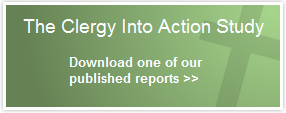Just as new clergy have some clear strengths in leading groups through decision-making processes, they also have common areas of weakness. The areas of decision-leadership in which new pastors and priests see themselves as less adept and needing more development have to do with strategic goal adjustment and assessment of work in process, interpersonal networks and power influences, conflict navigation, and personal anxiety management.
In the table below are the items that the most clergy saw as their weaker areas of decision leadership. For each question, Transition into Ministry alumni (clergy who benefited from unique post-seminary development programs) and non-TiM clergy are compared side by side with longer-term Episcopal priests in the prior Higher Quality study.1
It is worth noting that the fewest clergy judge themselves competent in outlining standards for assessing progress on projects and goals, arranging for improvements and changes midway through a decision process, and understanding how influence and information move through networks of people.
These are skills and capacities rarely taught during or after seminary. Yet without standards or benchmarks, it is difficult to say whether or not a group is actually making progress. Without insight and the adaptability to make adjustments in developing plans, projects and programs can stall and people can become frustrated or dispirited.
Without the ability to adequately read informal social networks, pastors and priests will consistently find themselves surprised by how decisions are made or changed—and will struggle to foster energetic, supportive, and trusting communication between different groups of people in the congregations and other organizations they lead.
Then there is a more fundamental concern: How well do newer pastors and priests manage their own anxiety? From the responses of TiM and non-TiM clergy—and from the earlier responses of longer-term Episcopal priests—few clergy (only 25% to 32%) feel that they have solid mastery of their own anxiety when facing or anticipating opposition and negative feedback.
It is crucial for pastors and priests to do the deeper spiritual and emotional work of recognizing, understanding, and coming to master their own anxiety. As we found in our earlier study with Episcopal priests, clergy who struggle with their own anxiety find themselves less self-confident and decisive, more cautious, less assertive, and less able to think and act clearly in decision leadership.
These weaker areas of decision leadership point to the need—and opportunity—for some focused training, education, and formation for clergy before, during, and after seminary. (See our Resources section for recommendations of introductory materials that clergy may find helpful.) Like other areas of leadership, this kind of self-development challenges clergy to develop their “meta-cognition”—their ability to think about their own thinking.
Besides training in these mental and psychological skills, clergy need deeper spiritual formation in order to practice personal and communal discernment. In the article Spiritual Discernment in Decision-Making, the Cabrini Mission Corps calls discernment “the process of making choices in the context of faith.”
“The choices in discernment are often not between good and bad choices but between several possible actions that are potentially good. The process of discernment helps individuals to find the greater good — where God is truly calling them.” Spiritual Discernment in Decision-Making 2
Related Articles
- Research: Decision Leadership: Clergy Strengths
- Story: Developing a Discerning Community: Steps Toward Collaborative Decision-Making
1 John Dreibelbis and David Gortner, Talented but Tenuous: A Profile of Clergy Temperaments and Leadership Skills, research report submitted to the Lilly Endowment (Evanston, IL: Seabury-Western Theological Seminary, 2002).
2 This article is available for download as a PDF file at http://cabrinimissioncorps.org/wp-content/uploads/2010/11/discernment.pdf.



